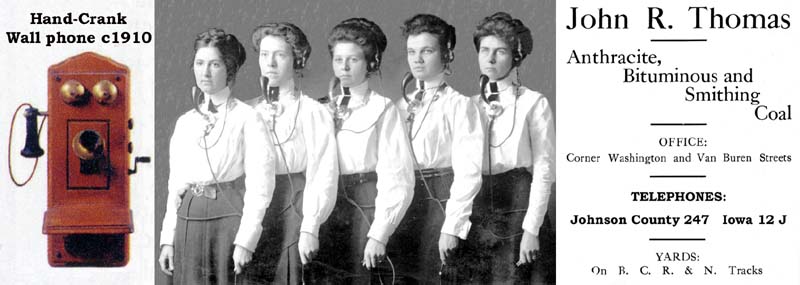The
telephone era began in Iowa City in 1881 when the first “Central” plugged
her headset and microphone into a huge box of equipment connections and said
“number please.” Luella
DeWolf made that first request seated at a console with dozens of possible
connecting lines located in a corner of the Western Union Telegraph office at
110 E. Washington St. managed by Frank Moffitt. The telegraph company
continued there until about 1975. She
then inserted a cable connected to the caller into a slot connected to the
phone being called. She was the vanguard of literally hundreds of mostly women
hired through the years to make the connection for each telephone call.
An accompanying image identifies a few of them as Alta Harman, Nelle
Cooney, Bertha DeFord, Bertha Dobson and Edna Arnett. They
even served as the “911” of their era in summoning emergency assistance
– 24 hours daily year around. During
a 1918 worldwide flu epidemic, telephone operators called every Iowa City home
soliciting blankets for emergency hospitals set up in the Elks Clubhouse then
downtown, the Masonic Temple and UI buildings. The
campus was put under marshal law. The epidemic eventually claimed 38 lives in
Iowa City, among 6,543 who died in Iowa, more than 500,000 in the U.S. and 20
million worldwide. Iowa
City Telephone Co. began with 35 phones on March 7, 1881, according to a June
1943 article in the State Historical Society’s Palimpsest magazine. The
local Republican newspaper reported 1,000 calls made during the first month. The
newspaper reported new phone numbers, including Whetstone drug 70, Iowa City
Glass Co. 63 and Shrader drug 64. It advised readers to add numbers to their
telephone list. The
first phone on the University of Iowa campus was installed in the
president’s office in Old Capitol in 1889, reports Margaret Keyes in her
1988 Old Capitol history. It was another 15 years before the first inside
toilets were installed in Old Cap, just a year before additional phones were
installed throughout the structure in 1905. A
second phone company headed by A.T. Averill, with Sam Mercer as vice
president, was initiated in 1900 as Johnson County Telephone Co. with separate
wires and poles running along the same streets as served the older phone
company. Rates
for the new company were $1.50 monthly for a private line, $1 for a party
line, and $2.50 for a business phone. The “party line” meant that it
served more than one phone, and anyone on the line could – and did –
listen in on calls to anyone else on that line. Advertisers
often listed two phone numbers in their advertisements. Iowa City Telephone
used two and three digits followed by a letter, as 12J; while Johnson County
typically used three numeric digits, as in 247. The
companies were merged in 1910 under the name Iowa City Telephone Co. It had a
new building built by paint store owner Byron Stillwell at 227 E. Washington
St., which is the second storefront east of where the Englert Theatre would be
built two years later. The author recalls a childhood home number as “Green
198.” The
first local long distance system was installed by AT&T in 1898. Absorbed
by the huge national Bell Telephone system, local phone operations were moved
in 1932 into a tall building at the corner of Burlington and Linn streets,
which still houses automated phone equipment. That
move was accompanied by initiation of rotary dial service locally, which
eliminated the need for operator assistance on most local calls. Now,
cell phones bring another innovation which moves another step from the
personal touch of a pleasant voice asking: “number please.” Next
Saturday: Civil War marked Iowa
City and UI. Bob Hibbs collects local postcards and other historic ephemera and researches history related to them. Copyright 2004 By Bob Hibbs |
